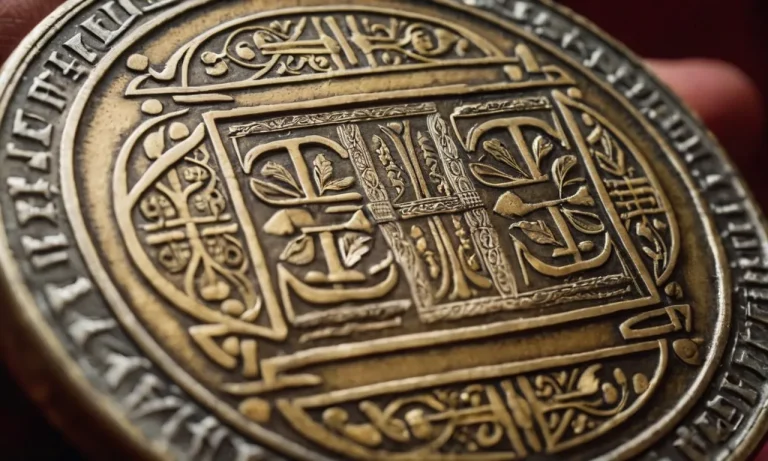Why Did Jesus Become Human? A Detailed Explanation
The question of why Jesus, the Son of God, chose to take on human form is central to Christian theology. For centuries, theologians and philosophers have grappled with this profound mystery in an attempt to understand the purposes and implications of the incarnation.
If you’re short on time, here’s a quick answer to your question: Jesus became human in order to save humankind from sin and restore our relationship with God. By taking on human flesh, Jesus bridged the gap between the divine and the human, making reconciliation possible.
In this comprehensive article, we will examine the various theological perspectives on the reasons for Christ’s incarnation. We will explore key biblical passages that provide insight into this question, review historical debates around it, and synthesize the views of influential Christian thinkers over the centuries.
By the end, you will have a thorough understanding of the meaning and significance of the Word becoming flesh.
Old Testament Background
Messianic Prophecies Foretold God Coming in Human Form
The Old Testament contains many prophecies that foretold the coming of a Messiah who would be God in human form. Here are some key examples:
- Isaiah 7:14 prophesied that the Messiah would be born of a virgin.
- Isaiah 9:6 reveals that the Messiah would be called “Mighty God.”
- Micah 5:2 foretold that the Messiah would be born in Bethlehem yet was from eternity past.
- Psalm 110 shows the Messiah would be both a king descended from David but also a priest forever in the order of Melchizedek.
These and other prophecies made it clear that while the Messiah would be a human descendant of David, he would also somehow be Immanuel, “God with us” (Isaiah 7:14). This mystery of how God could become man perplexed Old Testament believers, but was amazingly fulfilled in Jesus Christ.
Necessity of Sacrifice for Atonement of Sins
Another key theme in the Old Testament that paved the way for Christ’s incarnation was the concept that sacrifice and the shedding of blood was required for the atonement of sins. When Adam and Eve sinned, God made garments of animal skin to cover their nakedness (Genesis 3:21), foreshadowing the need for a substitutionary death to deal with the consequences of sin.
The entire Levitical system of sacrifice vividly illustrated this principle, with detailed procedures for offering bulls, goats and lambs to atone for the people’s sins (Leviticus 1-7). The Passover lamb (Exodus 12) and the sacrifices offered on the Day of Atonement (Leviticus 16) taught that God required the blood of a spotless, innocent victim in order to forgive His people.
These vivid object lessons could not solve the sin problem fully (Hebrews 10:4) but pointed ahead to the ultimate sacrifice of Christ.
Therefore, when John the Baptist called Jesus “the Lamb of God who takes away the sin of the world” (John 1:29), those familiar with the Old Testament sacrificial system recognized Jesus as the fulfillment of what the animal sacrifices could only picture.
The only way a Holy God could become united with sinful man in order to save him was through the reconciling blood of His own sinless Son.
New Testament Perspectives
Jesus as Sacrifice for Sins
The New Testament presents Jesus as the ultimate sacrifice for the sins of humanity. According to theologians, Jesus’ death on the cross served as an atonement for the sins of all people who choose to accept His sacrifice (Romans 3:25, Hebrews 9:28).
His innocent blood was shed so that forgiveness and reconciliation with God could be made available to all. This view is rooted in the concept from the Old Testament that “without the shedding of blood there is no forgiveness” (Hebrews 9:22).
Jesus willingly gave Himself up, taking the punishment that was due for humankind’s sins.
The sacrificial death of Jesus is considered unique and superior to previous animal sacrifices. While the blood of animals could provide ceremonial cleansing under the old covenant, Jesus’ blood brings genuine forgiveness and inner spiritual renewal in the new covenant (Hebrews 10:1-18).
Leading evangelical websites like GotQuestions.org emphasize that He is the “Lamb of God who takes away the sin of the world” (John 1:29). His once-for-all sacrifice redeems all those who put their faith in Him.
Jesus as Revelation of God
In addition to making atonement for sins, the coming of Jesus to earth also served to reveal the nature and character of God in an unprecedented way. Jesus is considered “the image of the invisible God” (Colossians 1:15) and the “exact representation of His being” (Hebrews 1:3).
Through His life, teachings, death, and resurrection, Jesus demonstrated God’s love, mercy, righteousness, and sovereignty over all creation.
According to theologian Graeme Goldsworthy, “God’s revelation of himself in Jesus is nothing less than the biblical Gospel presented in the context of the kingdom of God.” Jesus’ teachings about the Kingdom of God provide unique insight into God’s original intentions for human beings and all creation.
His miracles and Transfiguration reveal His divine glory and authority. Ultimately, His resurrection from the dead confirms His power over sin and death.
Jesus as Second Adam
Several New Testament writers, notably Paul, draw a parallel between Jesus and Adam, the first man created in Genesis. Just as Adam’s disobedience led the human race into sin and death, Christ’s obedience offers grace, righteousness, and eternal life (Romans 5:12-21).
According to evangelical theology, Jesus fulfills God’s original purpose for humanity to bear His image, live in intimate relationship with Him, and exercise benevolent dominion over creation (Genesis 1:26-28).
Where Adam failed and introduced sin, Jesus succeeded and reversed the curse through His flawless obedience. Evangelical scholar Dr. Hampton Keathley IV explains, “As the second Adam, Jesus came to undo all that the first Adam had done and restore fellowship with God.”
This will ultimately be accomplished when Christ returns to redeem both human beings and the entire natural world (Romans 8:18-25).
Theories from Historical Christian Thinkers
Irenaeus – Recapitulation Theory
Irenaeus, a 2nd century bishop and apologist, believed Jesus became human to reverse the course of human history and undo the damage caused by Adam’s sin. Just as Adam’s disobedience brought sin and death, Christ’s obedience brought righteousness and life.
By living a sinless human life, Jesus “recapitulated” and “summed up” human experience, sanctifying every stage of life. This view sees Jesus’ incarnation as the fulfillment of God’s original intentions for humanity.
Athanasius – Atonement and Divinization
Athanasius, a 4th century bishop, taught that Jesus became human to renew the image of God in humanity, which was corrupted by sin. By uniting human and divine natures in himself, Christ made it possible for humans to participate in the divine life through grace.
Athanasius used the phrase “God became man so that man might become God.” His view focused on restoration of communion with God through Christ’s atoning death and resurrection.
Anselm – Satisfaction Theory
Anselm, an 11th century archbishop, viewed Christ’s incarnation and death as providing satisfaction for human sin. Humans owed God a debt of honor that we could not repay. Therefore, God sent Christ as a substitute to make satisfaction on our behalf through his perfect life and death.
Anselm rejected punishment-based theories, arguing that Christ voluntarily gave his life as an act of obedience to restore our relationship with God.
Thomas Aquinas – Natural Fit Between Humanity and Divinity
Thomas Aquinas, a 13th century Dominican friar, believed the incarnation was the wisest way for God to restore humanity. Aquinas saw a natural fit between Christ’s divine and human natures. Human nature was originally created to be united with God, so Jesus lived the perfect human life we were intended for.
The incarnation reminds us of our divine purpose and empowers us to live virtuously by God’s grace.
Martin Luther – Revelation of God’s Love
Martin Luther, a seminal 16th century Protestant reformer, emphasized how Christ’s incarnation expresses God’s love. Luther preached that God became human in Christ not out of obligation, but willingly out of compassion.
Christ lived, died, and rose to demonstrate God’s unconditional love and forgiveness toward sinners. Luther believed this revelation of grace kindles faith and empowers joyful service to neighbors.
John Calvin – Revelation of God’s Glory
John Calvin, another major 16th century Reformer, stressed that God was revealed in Jesus Christ. Through the incarnation, Christ displayed God’s glory, wisdom, righteousness, and love. Calvin asserted that Christ had to become human to save us because only the Creator could repair the damage sin had done.
He viewed Christ’s life as a lesson in humility, trust, and obedience to God.
Karl Barth – Revelation of God’s Humility
Karl Barth, an influential 20th century theologian, argued that the incarnation displays God’s humility and condescension. Jesus reveals God’s nature by emptying himself of divine privileges to become a lowly human and die on a cross. For Barth, Christ’s humanity was the form of God’s active love.
The incarnation calls us to reject self-glorification and humbly serve others as God served us in Christ.
Modern Perspectives
Liberal Protestant Views
Many liberal Protestant theologians believe Jesus became human to reveal God’s love and grace to the world. They argue that through his teachings, acts of mercy, death on the cross, and resurrection, Jesus perfectly displayed the character of God and His desire for relationship with humanity (The Humanity of God).
By becoming one of us, Jesus bridged the gap between the divine and human, making God relatable and bringing hope of redemption.
Orthodox Views
In Orthodox theology, a key reason Jesus became human was to transform human existence through his incarnation, death, and resurrection. His taking on flesh united God with creation in a profound way, while his conquest of sin and death opened the portal for humanity’s deification – becoming “partakers of the divine nature” (2 Peter 1:4).
Jesus’ incarnation was therefore an amazing demonstration of God’s love for His people and His desire to draw them into intimate fellowship with Himself.
Roman Catholic Views
The predominant Roman Catholic perspective is that Jesus became human chiefly to make atonement for human sin. Building on the theology of leaders like Anselm of Canterbury, Catholics hold to a “satisfaction theory” of Christ’s work on the cross – namely, that God’s honor, slighted by human rebellion, required an infinite sacrifice to restore.
As true man, Jesus was able to represent humanity and make that sacrifice. Rising again, he opened the gates of heaven for believers. This view sees Jesus’ incarnation as fundamentally soteriological – aimed at human salvation through expiation of sins.
Conclusion
In this article, we have explored the incarnation of Jesus Christ from multiple vantage points – tracing the roots of this doctrine in the Old Testament, analyzing the New Testament portrayal of Christ’s humanity, reviewing theories from leading theologians across history, and considering modern perspectives.
While the mystery of the Word made flesh cannot be fully comprehended by our finite human minds, it is clear that this central Christian tenet carries profound meaning. At a basic level, the incarnation enabled Christ to die for humanity’s sins as our representative and substitute.
More broadly, Jesus’ life as one of us discloses God’s intimate identification with humankind and his desire to restore us to relationship with him. As the God-man, Jesus bridges earth and heaven and makes reconciliation possible.
Though debates around the mechanics and purposes of the incarnation will no doubt continue, all Christians affirm that in Christ, God has come near to dwell among us – revealing his glory, humility, and redeeming love through taking on human flesh.








